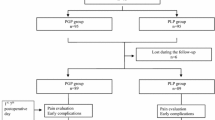Abstract
Purpose
The process of mesh fixation and the potential risk of associated chronic pain are always surgeon’s main concerns in hernia surgery. A wide variety of lightweight mesh models are currently available on the market to overcome some of these problems showing good preliminary results, but no data representing the medium- or long-term results. The present study aims to report the clinical outcomes of two institutional series of patients who underwent hernia repair using a partially absorbable auto adherent mesh (ParieteneTM ProgripTM—PP).
Methods
A prospective analysis was performed including unselected patients with primary groin hernia who underwent a standardized Lichtenstein procedure using the PP mesh at two tertiary institutions.
Results
During the 2-year study period, 181 patients (167 males; 14 females) with a median age of 63 years (19–85 years) were operated on at both centers. Short-term complications occurred in 27 patients (15%), the most commonly seen being urinary retention (6%) followed by hematoma (5%) and acute orchitis (2%). With a median follow-up of 17 months (12–29 months), 4 patients (2%) had a feeling of a foreign body in the groin, and 7 (4%) developed chronic pain. A total of four patients (2%) developed recurrence.
Conclusions
In our experience, the use of the PP mesh for hernioplasties offers a potential benefit not only in the short-term period but also in a medium-term follow-up with low recurrence and late chronic pain rates. However, this particular mesh does not fully prevent all complications and chronic pain and recurrent hernias have been reported for the first time.
Similar content being viewed by others
References
Van Veen RN, Wijsmuller AR, Vrijland WW, Hop WC, Lange JF, Jeekel J (2007) Long-term follow-up of a randomized clinical trial of non-mesh versus mesh repair of primary inguinal hernia. Br J Surg 94:506–510
Mokete M, Earnshaw JJ (2001) Evolution of an inguinal hernia surgery practice. Postgrad Med J 77:188–190
EU Hernia Trialists Collaboration (2000) Mesh compared with non-mesh methods of open groin hernia repair: systematic review of randomized controlled trials. Br J Surg 87:854–859
Chastan P (2005) Tension free inguinal hernia repair: a retrospective study of 3000 cases in one center. Int Surg 90:48–52
Amid PK (2003) The Lichtenstein repair in 2002: an overview of causes of recurrence after Lichtenstein tension-free hernioplasty. Hernia 7:13–16
Massaron S, Bona S, Fumagalli U, Battafarano F, Elmore U, Rosati R (2007) Analysis of post-surgical pain after inguinal hernia repair: a prospective study of 1,440 operations. Hernia 11:517–525
O’Dwyerl PJ, Kingsnorth AN, Molloy RG, Small PK, Lammers B, Horeyseck G (2005) Randomized clinical trial assessing impact of a lightweight or heavyweight mesh on chronic pain after inguinal hernia repair. Br J Surg 92:166–170
Smeds S, Kald A, Löfström L (2010) Crhonic pain after inguinal hernia repair: a longitudinal self-assessment study. Hernia 14:249–252
Loos MJA, Roumen RMH, Scheltinga MRM (2007) Classifying postherniorrhaphy pain syndromes following elective inguinal hernia repair. World J Surg 31:1760–1765
Chastan P (2009) Tension free open inguinal hernia repair using an innovative self gripping semi-resorbable mesh. Hernia 13(2):137–142
Bringman S, Conze J, Cuccurullo D, Deprest J, Junge K, Klosterhalfen B et al (2010) Hernia repair: the search for ideal meshes. Hernia 14:81–87
Nikkolo C, Lepner U, Murruste M, Vaasna T, Seepter H, Tikk T (2010) Randomised clinical trial comparing lightweight mesh with heavyweight mesh for inguinal hernioplasty. Hernia 14:253–258
Esteban MB, Pallararés MC, Rojas Enrique Argiues Sánches De (2010) Use of adhesive mesh in hernioplasty compared to the conventional technique. Results of a randomised prospective study. CIR ESP 88(4):253–258
Bringman S, Wollert S, Osterberg J, Smedberg S, Granlund H, Heikkinen TJ (2006) Three-year results of a randomized clinical trial of lightweight or standard polypropylene mesh in Lichtenstein repair of primary inguinal hernia. Br J Surg 93:1056–1059
Miserez M, Alexandre JH, Campanelli G, Corcione F, Cuccurullo D, Pascual MH et al (2007) The European hernia society groin hernia classication: simple and easy to remember. Hernia 11:113–116
Simons MP, Aufenacker T, Bay-Nielsen M, Bouillot JL, Campanelli G, Conze J et al (2009) European Hernia Society guidelines on the treatment of inguinal hernia in adult patients. Hernia 13:343–403
Kapischke M, Schulze H, Caliebe A (2010) Self-fixating mesh for the Lichtenstein procedure—a prestudy. Langenbecks Arch Surg 395:317–322
Bisgaard T, Bay-Nielsen M, Christensen IJ, Kehlet H (2007) Risk of recurrence 5 years or more after primary Lichtenstein mesh and sutured inguinal hernia repair. Br J Surg 94(8):1038–1040
George H, Sakorafas IH, Nissotakis C, Kotsifopoulos N, Stavrou A, Antonopoulos C et al (2001) Open tension free repair of inguinal hernias; the Lichtenstein technique. BMC Surg 1:3
Acknowledgments
We thank Sara Calvo Rosenstone for editing this manuscript.
Conflicts of interest
None.
Author information
Authors and Affiliations
Corresponding author
Rights and permissions
About this article
Cite this article
Pedano, N., Pastor, C., Arredondo, J. et al. Open tension-free hernioplasty using a novel lightweight self-gripping mesh: medium-term experience from two institutions. Langenbecks Arch Surg 397, 291–295 (2012). https://doi.org/10.1007/s00423-011-0831-6
Received:
Accepted:
Published:
Issue Date:
DOI: https://doi.org/10.1007/s00423-011-0831-6




